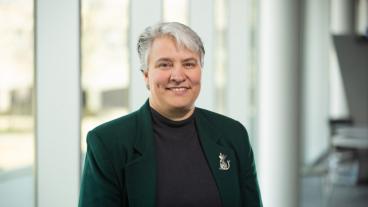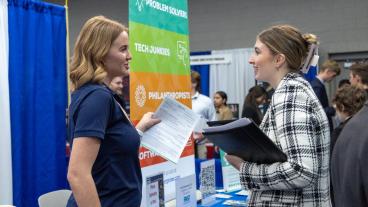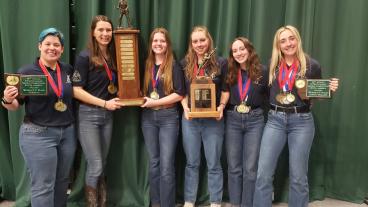The 1959 Chevrolet Bel Air looks prepped for a vintage auto show, but a different fate awaits. All fins and sharp edges, it takes off straight at a silver teardrop of a Chevy Malibu a half-century younger.
The closing speed is 80 mph, notes University Emeritus Professor David Matlock, a member of the National Academy of Engineering, whose computer monitor presents this generational clash.
The crash-test dummy is crunched in the collapsed cabin of the ’59. The one in the ’09 sits as it had before, spared by advances in automotive engineering and high-strength steel. There are many kinds of steel in a modern vehicle frame, Matlock explains, each designed with an exact set of properties which, in combination, has helped make cars much safer.
Matlock co-founded Mines’ Advanced Steel Processing and Products Research Center (ASPPRC) in 1984 with University Professor Emeritus George Krauss. By the early 1980s, American steel-industry research labs had begun to shrink and university funding for ferrous metallurgy had all but disappeared. Krauss and Matlock approached steel companies with the idea of partnering on a university-industry steel research center, in which a consortium of industry competitors, suppliers and customers would discuss the industry’s unmet research needs, set the science agenda and share results. Mines strengths in ferrous metallurgy research and teaching made it a logical hub.
Six companies signed on, and the National Science Foundation provided seed funding. The center survived a variety of changes in the landscape, including significant industry consolidation in the early 2000s, with member companies merging (for example, five of the current members now represent what was at one time 18 discrete ASPPRC members) as well as globalization of the steel and manufacturing industries.
Constant throughout, though, has been a focus on the research needs of industrial partner member companies that include many of the world’s biggest names in steel, automotive, heavy industry and oil and gas. In addition to annual dues to the center, they commit to sending one or more staff to biannual meetings in Golden where students present, and companies and researchers map the road ahead.
Thirty-one years since its founding, the ASPPRC’s focus on collaboration continues, with 31 companies from 13 countries now jointly setting the course and sharing the fruits of advances in testing methodologies and alloying strategies, and production processes. Eight full or part time Mines faculty lead a team of five research assistants, four postdoctoral researchers and 31 graduate students on a wide array of projects.
Member companies have hired many of these ASPPRC students, including Grant Thomas, a research engineer at AK Steel in Middletown, Ohio, who earned his Mines master’s and doctorate degrees for his ASPPRC work. The center, he said, is “industrially driven, so they’re relevant, and they have the time, the resources, and the equipment that really lets them get to the core of the problem — or opportunity, which are one in the same.”
Wang Li, a senior engineer and member of the board of directors at China’s Baosteel, the world’s fourth-largest steel producer, cited four major benefits in its ASPPRC membership: sponsors share in the center’s research achievements; it’s a good platform for interaction with other sponsors, including steel producers and users; it’s an opportunity for Baosteel staff to get involved in automotive steel research (Baosteel has a researcher doing a fellowship at the ASPPRC); and in helping set the research agenda, Baosteel gains early insights into trends in automotive steel.
All members receive royalty-free licenses for technologies that emerge from the center’s work. Despite many members being competitors, the nature of the business helps this sharing model work, said AK Steel’s Thomas. Fundamental insights into the behavior of a certain type of steel processed in a certain way — the ASPPRC’s calling card — can be taken different directions by different firms, all who have proprietary production techniques and established lines that can cost hundreds of millions of dollars.
“That’s where the competitive part comes in: putting it to use in a specific mill,” Thomas said.
Mines Professor John Speer, who has been ASPPRC director since 2013, spent 14 years at Bethlehem Steel before coming to Mines in 1997, said “we work hard to be relevant because many of the sponsor companies have outstanding corporate research facilities of their own. If the companies become interested in working on an idea we are pursuing, they can put a lot of people on it very quickly. Some of these companies have a thousand researchers.”
“Mines’ advantage,” he said, “is time.”
“If you’re fighting the daily fires of industry, it can be more difficult to sit back and think about the fundamentals,” Speer said, “or on potential processing routes that do not match existing facility investments.”
The ASPPRC’s research focuses on simulating solid state processing done on steel (after it has solidified), explained Assistant Professor Emmanuel De Moor. Important considerations can include combinations of alloying, heating, cooling, or changing its shape at different temperatures.
The center is focused on three major categories of steel: sheet, bar and plate. Sheet steel research is mainly driven by automotive needs; while bar steel research includes cables, gears, crankshafts, axles and wire; and plate steel activities are related to oil and gas pipelines, earth moving equipment, wind-turbine towers, ships, etc.
If the center’s research has a common focus, it’s on microstructure and properties. De Moor, an alloying and thermochemical processing expert, is interested in microstructure along with Associate Professor Kip Findley, a mechanicalproperties specialist whose students spend their days analyzing steel properties and performance. Microstructure, they explain, dictates the steel’s ultimate strength, ductility, formability and hardness.
Caryn Ritosa, a PhD student, is doing her work on the Gleeble 3500, a thermomechanical processing simulator — in this case mimicking an industrial process called multi-pass plate rolling. She’s testing six different steels, each about as thick as a pencil representing the thick plate steel used in pipelines. They’re low carbon, with microalloying additions such as niobium, vanadium and titanium. Ritosa heats each to an orange-red 1,250 degrees Celsius, then commands the Gleeble to twist them 180 degrees, 360 degrees and beyond. Her goal, she said, is to understand how the steel’s recrystallization behavior at high temperature affects its microstructure, with the ultimate goal being to produce higher strength steels at lower cost.
In another lab around the corner, PhD student Lee Rothleutner is fatigue-testing thumb-thick bars, each hour-glassed along the length, of induction-hardened steel. Automakers are interested in improving this steel for drivetrains, he said. Automotive lightweighting is a hot topic in steel, informing many ASPPRC experiments: average light-duty fuel economy standards are poised to leap from today’s 32.5 mpg to 54.5 mpg in 2025. The less a car weighs, the less fuel it takes to move it.
“The drivetrain is really one area of the automobile that hasn’t been intensely lightweighted,” he said. He mounts an article specimen in a fatigue tester that rumbles at a motion-blurring 30 hertz. As Rothleutner works the machine, Findley explains, “Over time, he’ll look at alloying effects, processing effects and some in combination. Which has a better fatigue life? Where are the cracks initiating? How?”
Back in Matlock’s office, shelves of engineering books share space with scores of snapped bits of steel whose failures helped keep so many drivers alive.
This story originally appeared in the 2015-16 issue of "Colorado School of Mines Research."



